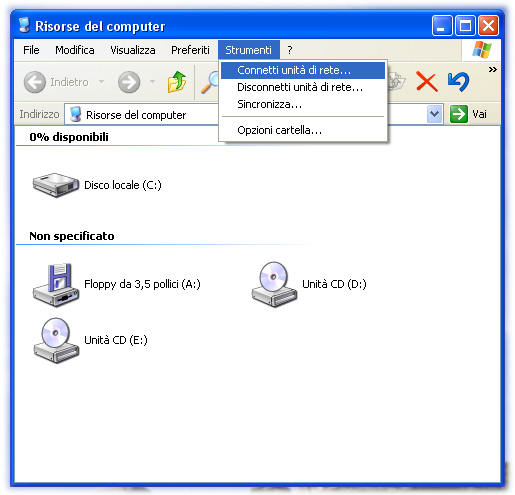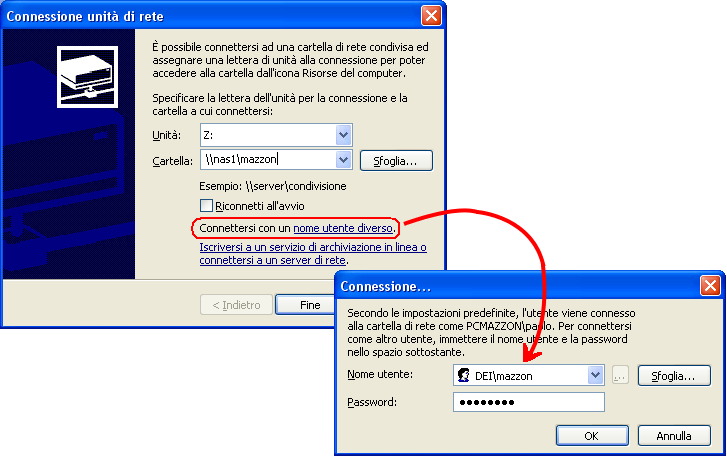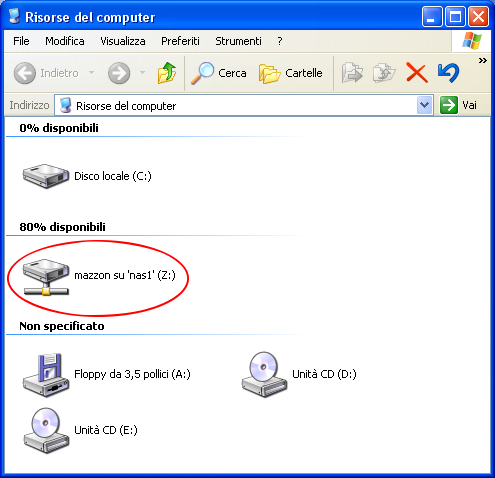It is possible to access account resources on both Windows systems (DEI domain) and departmental Linux systems using the same set of credentials (username and password). Therefore, it is no longer necessary to request two different authorizations as was done in the past.
The same personal data is now accessible from both operating environments in a single directory, which can be reached via the path:
Every time a user of the departmental network connects to a PC on the DEI network with their own account, they have the ability to retrieve their personal data (or at least a part of it) regardless of the physical location of the machine they are using.
For example, when logging into a Windows environment, everyone will find their own "Documents" folder, "Desktop", etc., along with all the data that forms the user profile. The Unix/Linux system user, on the other hand, once they have successfully completed the login phase, will have access to all the data that forms, in jargon, their home directory.
This functionality is guaranteed by the "distributed" nature of the departmental network: in fact, the simple process of entering "username" and "password" triggers a series of communications that allow, among other things, the verification of entered credentials, network access to personal data, or checking for new emails in one's mailbox.
Each user of the departmental network, depending on their qualification (with some exceptional cases), is allocated a limited amount of disk space on the departmental storage (NAS) to store their personal data.
The quotas currently in use at DEI are summarized in the following table:
| Affiliation group | Assigned disk quota SOFT limit |
Assigned disk quota HARD limit |
Research Fellow |
50GB | 50GB |
| Collaborator | 50GB | 50GB |
| Teacher | 50GB | 50GB |
| External teacher | 50GB | 50GB |
| PhD Student | 50GB | 50GB |
| Guest | 50GB | 50GB |
| Technical-Administrative Staff | 50GB | 50GB |
| Student | 20GB | 25GB |
| Thesis Student | 20GB | 25GB |
| Note: values are rounded | ||
The soft quota is the one above which a warning message is sent to the user: once this threshold is exceeded, it is still possible to access one's data for a certain period of time (grace period, usually one week) to "clean up". After this period or if the hard quota is exceeded, access to the data is blocked and it is necessary to contact the system administrators to restore functionality.
The space made available to you on the network storage is limited: you might fill it up (a situation commonly referred to as being over quota). The symptoms are varied: program freezes, computer slowdowns, or similar issues.
You can monitor your disk quota situation by accessing a Linux PC and using the command
showquotaAn example of output under normal conditions is:
showquota
Disk quotas for user utente (uid 1234):
Filesystem blocks quota limit grace files quota limit grace
/home/utente
121M 14800M 15000M 1847 4295m 4295m
/mail/utente
208 500M 550M 22 4295m 4295m
The indications should be read as follows: regarding the home directory, against an available quota of 14800 megabytes (about 15 gigabytes), my data currently occupies 121 megabytes. If I were to exceed the 14800 MB limit, additional files could be added extraordinarily until reaching the threshold of 15000 megabytes, at which point no more files will be written. Similar indications apply to the space for emails.
If I were to go over quota, the indications would instead be similar to these:
showquotaDisk quotas for user fuoriquota (uid 1234):
Filesystem blocks quota limit grace files quota limit grace
/home/fuoriquota
299M* 250M 300M 3972 4295m 4295m
/mail/fuoriquota
8900 500M 550M 116 4295m 4295m
Note the asterisk in the 299M* indication.
As you can see, the user in question has allocated 299MB of data against a quota of 250MB.
PLEASE NOTE: Windows profile data (the Documents folder, Desktop, etc.) are stored in the folder
/home/user/windows_profile
This folder, along with
/home/user/.windows_reg
should absolutely not be removed in their entirety, but it is of course possible to delete some of the files within them.
The solution, in case you've gone over quota, is clearly the deletion or moving of some of your data (for example, storing them on an external hard drive or USB stick). A non-exhaustive list of data that could be considered sacrificable might include: temporary internet browser files, obsolete files, emails that you can archive somewhere else, files that you could re-download from the internet at a later time, etc.
To quickly attempt to delete temporary files generated by browsers in Linux, you can use the command from the terminal
zerocache
If it's not clear to you where the files that are filling up your disk space are located, you can use (again from a Linux PC) the tool
spazio
This program, when launched from within any folder in your personal space, calculates the disk usage of all subfolders and files, including Linux "hidden" ones (those whose names begin with the '.' character and which you normally don't see using only the 'ls' command). For example (the commands after the '$' symbol are the ones you should type):
$ showquota
Disk quotas for user utente (uid 1234):
Filesystem blocks quota limit grace files quota limit grace
/home/utente
121M 14800M 15000M 1847 4295m 4295m
/mail/utente
208 500M 550M 22 4295m 4295m
$ pwd
/home/utente
$ spazio
Calculating: please wait...
...
...
2632 .windows-reg/
3400 .pulse/
6432 windows_profile/
7576 .cache/
7592 .kde/
28308 .local/
54304 .mozilla/
Note: values in kilobytes.
The largest files or folders are those indicated last: in this case, the user's .mozilla folder is the one occupying the most space. If you want to free up some space (for example, by deleting Firefox browser temporary files contained in this folder), you could proceed as follows:
$ cd .mozilla/firefox
$ ls
m9j4va3h.default pluginreg.dat profiles.ini
$ cd m9j4va3h.default
$ spazio
...
...
35140 Cache/
Note: Values in kilobytes.
$ cd Cache
$ rm -f *
$ showquota
Disk quotas for user utente (uid 1234):
Filesystem blocks quota limit grace files quota limit grace
/home/utente
88488 14800M 15000M 1719 4295m 4295m
/mail/utente
208 500M 550M 22 4295m 4295m
As you can notice, the occupied disk space has decreased from the initial 121 megabytes to 88 megabytes.
Please consult the section of interest:
User connecting to a PC in the DEI domain
User connecting to a generic Windows PC
User connecting to a Linux PC on the DEI network
User connecting to a generic Linux PC
User connecting to a PC in the DEI domain
When a user is using their assigned account to access the Department's IT resources on a PC in the DEI domain, by accessing "Computer Resources" they will find their "Documents" folder and a storage unit indicated as "Z:" automatically made available by the system.
User connecting to a generic Windows PC
In this case, personal data must be explicitly made visible by connecting it to your PC as a network drive. If, for example, my account is mazzon:
my DEI windows profile is \\nas1\mazzon\windows_profile
To access them, I can use the "map network drive" functionality

providing the appropriate credentials for authentication:

The resource will appear as if it were another disk on my PC:

Alternatively, graphical clients can be used for remote access or copying.
A free client we recommend for this purpose can be downloaded from this link.
NOTE: The directories \nas1\user.windows-reg and \nas1\user\windows_profile are necessary for the correct functioning of the account in a Windows environment and MUST NOT BE REMOVED UNDER ANY CIRCUMSTANCES.
User connecting to a Linux PC on the DEI network
When a user is using their assigned account to access the Department's IT resources on a PC on the DEI network, the data in their home directory is automatically accessed via the network and is located in the /home/user directory.
User connecting to a generic Linux PC
In this case, personal data is accessible by remotely connecting (ssh) to machines on the DEI network. If you want to copy part of your data to your personal PC, you will need to use secure copy clients (scp).
NOTE: The directories /home/user/.windows-reg and /home/user/windows_profile are necessary for the correct functioning of the account in a Windows environment and MUST NOT BE REMOVED UNDER ANY CIRCUMSTANCES.
Please consult the Remote Terminal Access (SSH) page.
The storage management system (NAS) allows "read-only" access to "snapshots" of personal data that are created at various intervals. This way, you have security copies of your files from different times which, in case of accidental deletion or modification, allow you to autonomously restore the data.
These directories are located in
/home/user/.snapshot in Linux environment
Inside, you'll find directories named 8hours... daily.... weekly.... which are updated every 8 hours, every day, and every week respectively; their names end with the date and time they were updated
e.g., the directory 8hour.2023-10-06_1200 was updated at noon on October 6, 2023
It's important to remember that the files contained in these directories DO NOT affect the user's available disk quota.
This guide describes the procedure that allows PCs enabled for access to the departmental network (laptops and desktops) to backup user-selected data by saving it on the network storage (NAS).
Download the user manual and the program from the links below.